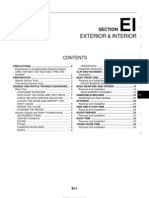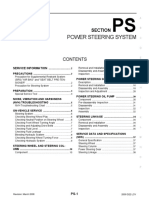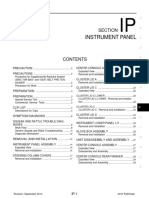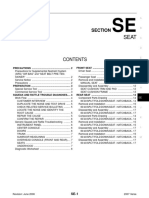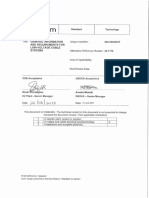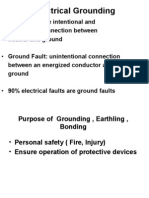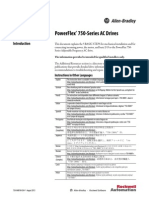Ip PDF
Ip PDF
Uploaded by
Jesus Mario Hernandez RuizCopyright:
Available Formats
Ip PDF
Ip PDF
Uploaded by
Jesus Mario Hernandez RuizOriginal Title
Copyright
Available Formats
Share this document
Did you find this document useful?
Is this content inappropriate?
Copyright:
Available Formats
Ip PDF
Ip PDF
Uploaded by
Jesus Mario Hernandez RuizCopyright:
Available Formats
I BODY
INSTRUMENT PANEL
SECTION IP B
E
CONTENTS
PRECAUTIONS .......................................................... 2 INSTRUMENT PANEL .......................................... 6 F
Precautions for Supplemental Restraint System CENTER CONSOLE ............................................. 6
(SRS) “AIR BAG” and “SEAT BELT PRE-TEN- DOORS ................................................................. 6
SIONER” .................................................................. 2 TRUNK .................................................................. 7 G
Precautions .............................................................. 2 SUNROOF/HEADLINING ..................................... 7
PREPARATION ........................................................... 3 OVERHEAD CONSOLE (FRONT AND REAR)..... 7
Special Service Tools ............................................... 3 SEATS ................................................................... 7
H
Commercial Service Tools ........................................ 3 UNDERHOOD ....................................................... 7
SQUEAK AND RATTLE TROUBLE DIAGNOSES..... 4 Diagnostic Worksheet ............................................... 8
Work Flow ................................................................ 4 INSTRUMENT PANEL ASSEMBLY ......................... 10
CUSTOMER INTERVIEW ..................................... 4 Component Parts .................................................... 10 IP
DUPLICATE THE NOISE AND TEST DRIVE ....... 5 Removal and Installation ........................................ 11
CHECK RELATED SERVICE BULLETINS ........... 5 INSTRUMENT PANEL ASSEMBLY .................... 11
LOCATE THE NOISE AND IDENTIFY THE CLUSTER LID C ................................................. 14 J
ROOT CAUSE ...................................................... 5 COMBINATION METER ...................................... 15
REPAIR THE CAUSE ........................................... 5 GLOVE BOX ASSEMBLY ................................... 15
CONFIRM THE REPAIR ....................................... 6 INSTRUMENT LOWER FINISHER ..................... 17
K
Generic Squeak and Rattle Troubleshooting ........... 6 CENTER CONSOLE ASSEMBLY ....................... 17
Revision: December 2006 IP-1 2007 Sentra
PRECAUTIONS
PRECAUTIONS PFP:00001
Precautions for Supplemental Restraint System (SRS) “AIR BAG” and “SEAT
BELT PRE-TENSIONER” EIS00BEQ
The Supplemental Restraint System such as “AIR BAG” and “SEAT BELT PRE-TENSIONER”, used along
with a front seat belt, helps to reduce the risk or severity of injury to the driver and front passenger for certain
types of collision. This system includes seat belt switch inputs and dual stage front air bag modules. The SRS
system uses the seat belt switches to determine the front air bag deployment, and may only deploy one front
air bag, depending on the severity of a collision and whether the front occupants are belted or unbelted.
Information necessary to service the system safely is included in the SRS and SB section of this Service Man-
ual.
WARNING:
● To avoid rendering the SRS inoperative, which could increase the risk of personal injury or death
in the event of a collision which would result in air bag inflation, all maintenance must be per-
formed by an authorized NISSAN/INFINITI dealer.
● Improper maintenance, including incorrect removal and installation of the SRS, can lead to per-
sonal injury caused by unintentional activation of the system. For removal of Spiral Cable and Air
Bag Module, see the SRS section.
● Do not use electrical test equipment on any circuit related to the SRS unless instructed to in this
Service Manual. SRS wiring harnesses can be identified by yellow and/or orange harnesses or
harness connectors.
Precautions EIS00BER
● Disconnect both battery terminals in advance.
● Disconnect air bag system line in advance.
● Never tamper with or force air bag lid open, as this may adversely affect air bag performance.
● Be careful not to scratch pad and other parts.
● When removing or disassembling any part, be careful not to damage or deform it. Protect parts which may
get in the way with cloth.
● When removing parts, protect parts by wrapping tools with vinyl or tape.
● Keep removed parts protected with cloth.
● If a clip is deformed or damaged, replace it.
● If an non-reusable part is removed, replace it with a new one.
● Tighten bolts and nuts firmly to the specified torque.
● After re-assembly has been completed, make sure each part functions correctly.
● Remove stains in the following way.
Water-soluble stains:
Dip a soft cloth in warm water, and then squeeze it tightly. After wiping the stain, wipe with a soft dry cloth.
Oil stain:
Dissolve a synthetic detergent in warm water (density of 2 to 3% or less), dip the cloth, then clean off the stain
with the cloth. Next, dip the cloth in fresh water and squeeze it tightly. Then clean off the detergent completely.
Then wipe the area with a soft dry cloth.
● Do not use any organic solvent, such as thinner or benzine.
Revision: December 2006 IP-2 2007 Sentra
PREPARATION
PREPARATION PFP:00002
A
Special Service Tools EIS00BES
The actual shapes of Kent-Moore tools may differ from those of special service tools illustrated here.
Tool number B
(Kent-Moore No.) Description
Tool name
— Locating the noise C
(J-39570)
Chassis ear
SIIA0993E
E
— Repairing the cause of noise
(J-43980)
NISSAN Squeak and Rattle
Kit F
SIIA0994E G
Commercial Service Tools EIS00BET
Tool name Description H
Engine ear Locating the noise
IP
J
SIIA0995E
Power tool Loosening bolts and nuts
K
PBIC0191E
Revision: December 2006 IP-3 2007 Sentra
SQUEAK AND RATTLE TROUBLE DIAGNOSES
SQUEAK AND RATTLE TROUBLE DIAGNOSES PFP:00000
Work Flow EIS00BEU
SBT842
CUSTOMER INTERVIEW
Interview the customer, if possible, to determine the conditions that exist when the noise occurs. Use the Diag-
nostic Worksheet during the interview to document the facts and conditions when the noise occurs and any
customer's comments; refer to IP-8, "Diagnostic Worksheet" . This information is necessary to duplicate the
conditions that exist when the noise occurs.
● The customer may not be able to provide a detailed description or the location of the noise. Attempt to
obtain all the facts and conditions that exist when the noise occurs (or does not occur).
● If there is more than one noise in the vehicle, be sure to diagnose and repair the noise that the customer
is concerned about. This can be accomplished by test driving the vehicle with the customer.
● After identifying the type of noise, isolate the noise in terms of its characteristics. The noise characteristics
are provided so the customer, service adviser and technician are all speaking the same language when
defining the noise.
– Squeak — (Like tennis shoes on a clean floor)
Squeak characteristics include the light contact/fast movement/brought on by road conditions/hard sur-
faces = higher pitch noise/softer surfaces = lower pitch noises/edge to surface = chirping.
– Creak — (Like walking on an old wooden floor)
Creak characteristics include firm contact/slow movement/twisting with a rotational movement/pitch
dependent on materials/often brought on by activity.
– Rattle — (Like shaking a baby rattle)
Rattle characteristics include the fast repeated contact/vibration or similar movement/loose parts/missing
clip or fastener/incorrect clearance.
– Knock — (Like a knock on a door)
Knock characteristics include hollow sounding/sometimes repeating/often brought on by driver action.
– Tick — (Like a clock second hand)
Tick characteristics include gentle contacting of light materials/loose components/can be caused by driver
action or road conditions.
– Thump — (Heavy, muffled knock noise)
Thump characteristics include softer knock/dead sound often brought on by activity.
– Buzz — (Like a bumblebee)
Buzz characteristics include high frequency rattle/firm contact.
● Often the degree of acceptable noise level will vary depending upon the person. A noise that you may
judge as acceptable may be very irritating to the customer.
● Weather conditions, especially humidity and temperature, may have a great effect on noise level.
Revision: December 2006 IP-4 2007 Sentra
SQUEAK AND RATTLE TROUBLE DIAGNOSES
DUPLICATE THE NOISE AND TEST DRIVE
If possible, drive the vehicle with the customer until the noise is duplicated. Note any additional information on A
the Diagnostic Worksheet regarding the conditions or location of the noise. This information can be used to
duplicate the same conditions when you confirm the repair.
If the noise can be duplicated easily during the test drive, to help identify the source of the noise, try to dupli- B
cate the noise with the vehicle stopped by doing one or all of the following:
1. Close a door.
2. Tap or push/pull around the area where the noise appears to be coming from. C
3. Rev the engine.
4. Use a floor jack to recreate vehicle “twist”.
5. At idle, apply engine load (electrical load, half-clutch on M/T model, drive position on A/T model). D
6. Raise the vehicle on a hoist and hit a tire with a rubber hammer.
● Drive the vehicle and attempt to duplicate the conditions the customer states exist when the noise occurs.
E
● If it is difficult to duplicate the noise, drive the vehicle slowly on an undulating or rough road to stress the
vehicle body.
F
CHECK RELATED SERVICE BULLETINS
After verifying the customer concern or symptom, check ASIST for Technical Service Bulletins (TSBs) related
to that concern or symptom. G
If a TSB relates to the symptom, follow the procedure to repair the noise.
LOCATE THE NOISE AND IDENTIFY THE ROOT CAUSE
1. Narrow down the noise to a general area. To help pinpoint the source of the noise, use a listening tool H
(Chassis Ear: J-39570, Engine Ear: J-39565, and mechanics stethoscope).
2. Narrow down the noise to a more specific area and identify the cause of the noise by:
● Removing the components in the area that you suspect the noise is coming from. IP
Do not use too much force when removing clips and fasteners, otherwise clips and fasteners
can be broken or lost during the repair, resulting in the creation of new noise.
● Tapping or pushing/pulling the component that you suspect is causing the noise. J
Do not tap or push/pull the component with excessive force, otherwise the noise will be elimi-
nated only temporarily.
● Feeling for a vibration with your hand by touching the component(s) that you suspect is (are) causing
K
the noise.
● Placing a piece of paper between components that you suspect are causing the noise.
● Looking for loose components and contact marks. L
Refer to IP-6, "Generic Squeak and Rattle Troubleshooting" .
REPAIR THE CAUSE
● If the cause is a loose component, tighten the component securely. M
● If the cause is insufficient clearance between components:
– Separate components by repositioning or loosening and retightening the component, if possible.
– Insulate components with a suitable insulator such as urethane pads, foam blocks, felt cloth tape or ure-
thane tape. A NISSAN Squeak and Rattle Kit (J-43980) is available through your authorized NISSAN
Parts Department.
CAUTION:
Do not use excessive force as many components are constructed of plastic and may be damaged.
Always check with the Parts Department for the latest parts information.
The following materials are contained in the NISSAN Squeak and Rattle Kit (J-43980). Each item can be
ordered separately as needed.
URETHANE PADS [1.5 mm (0.059 in) thick]
Insulates connectors, harness, etc.
76268-9E005: 100 x 135 mm (3.94 x 5.31 in)/76884-71L01: 60 x 85 mm (2.36 x 3.35 in)/76884-71L02: 15 x 25
mm (0.59 x 0.98 in)
INSULATOR (Foam blocks)
Insulates components from contact. Can be used to fill space behind a panel.
Revision: December 2006 IP-5 2007 Sentra
SQUEAK AND RATTLE TROUBLE DIAGNOSES
73982-9E000: 45 mm (1.77 in) thick, 50 x 50 mm (1.97 x 1.97 in)/73982-50Y00: 10 mm (0.39 in) thick, 50 x 50
mm (1.97 x 1.97 in)
INSULATOR (Light foam block)
80845-71L00: 30 mm (1.18 in) thick, 30 x 50 mm (1.18 x 1.97 in)
FELT CLOTH TAPE
Used to insulate where movement does not occur. Ideal for instrument panel applications.
68370-4B000: 15 x 25 mm (0.59 x 0.98 in) pad/68239-13E00: 5 mm (0.20 in) wide tape roll
The following materials, not found in the kit, can also be used to repair squeaks and rattles.
UHMW (TEFLON) TAPE
Insulates where slight movement is present. Ideal for instrument panel applications.
SILICONE GREASE
Used in place of UHMW tape that will be visible or not fit.
Note: Will only last a few months.
SILICONE SPRAY
Use when grease cannot be applied.
DUCT TAPE
Use to eliminate movement.
CONFIRM THE REPAIR
Confirm that the cause of a noise is repaired by test driving the vehicle. Operate the vehicle under the same
conditions as when the noise originally occurred. Refer to the notes on the Diagnostic Worksheet.
Generic Squeak and Rattle Troubleshooting EIS00BEV
Refer to Table of Contents for specific component removal and installation information.
INSTRUMENT PANEL
Most incidents are caused by contact and movement between:
1. The cluster lid A and instrument panel
2. Acrylic lens and combination meter housing
3. Instrument panel to front pillar garnish
4. Instrument panel to windshield
5. Instrument panel mounting pins
6. Wiring harnesses behind the combination meter
7. A/C defroster duct and duct joint
These incidents can usually be located by tapping or moving the components to duplicate the noise or by
pressing on the components while driving to stop the noise. Most of these incidents can be repaired by apply-
ing felt cloth tape or silicone spray (in hard to reach areas). Urethane pads can be used to insulate wiring har-
ness.
CAUTION:
Do not use silicone spray to isolate a squeak or rattle. If you saturate the area with silicone, you will
not be able to recheck the repair.
CENTER CONSOLE
Components to pay attention to include:
1. Shifter assembly cover to finisher
2. A/C control unit and cluster lid C
3. Wiring harnesses behind audio and A/C control unit
The instrument panel repair and isolation procedures also apply to the center console.
DOORS
Pay attention to the:
1. Finisher and inner panel making a slapping noise
2. Inside handle escutcheon to door finisher
3. Wiring harnesses tapping
4. Door striker out of alignment causing a popping noise on starts and stops
Revision: December 2006 IP-6 2007 Sentra
SQUEAK AND RATTLE TROUBLE DIAGNOSES
Tapping or moving the components or pressing on them while driving to duplicate the conditions can isolate
many of these incidents. You can usually insulate the areas with felt cloth tape or insulator foam blocks from A
the NISSAN Squeak and Rattle Kit (J-43980) to repair the noise.
TRUNK
Trunk noises are often caused by a loose jack or loose items put into the trunk by the owner. B
In addition look for:
1. Trunk lid bumpers out of adjustment
2. Trunk lid striker out of adjustment C
3. The trunk lid torsion bars knocking together
4. A loose license plate or bracket
D
Most of these incidents can be repaired by adjusting, securing or insulating the item(s) or component(s) caus-
ing the noise.
SUNROOF/HEADLINING E
Noises in the sunroof/headlining area can often be traced to one of the following:
1. Sunroof lid, rail, linkage or seals making a rattle or light knocking noise
2. Sun visor shaft shaking in the holder F
3. Front or rear windshield touching headliner and squeaking
Again, pressing on the components to stop the noise while duplicating the conditions can isolate most of these
incidents. Repairs usually consist of insulating with felt cloth tape. G
OVERHEAD CONSOLE (FRONT AND REAR)
Overhead console noises are often caused by the console panel clips not being engaged correctly. Most of H
these incidents are repaired by pushing up on the console at the clip locations until the clips engage.
In addition look for:
1. Loose harness or harness connectors.
IP
2. Front console map/reading lamp lens loose.
3. Loose screws at console attachment points.
SEATS J
When isolating seat noise it's important to note the position the seat is in and the load placed on the seat when
the noise is present. These conditions should be duplicated when verifying and isolating the cause of the
noise. K
Cause of seat noise include:
1. Headrest rods and holder
2. A squeak between the seat pad cushion and frame L
3. The rear seatback lock and bracket
These noises can be isolated by moving or pressing on the suspected components while duplicating the con-
ditions under which the noise occurs. Most of these incidents can be repaired by repositioning the component M
or applying urethane tape to the contact area.
UNDERHOOD
Some interior noise may be caused by components under the hood or on the engine wall. The noise is then
transmitted into the passenger compartment.
Causes of transmitted underhood noise include:
1. Any component mounted to the engine wall
2. Components that pass through the engine wall
3. Engine wall mounts and connectors
4. Loose radiator mounting pins
5. Hood bumpers out of adjustment
6. Hood striker out of adjustment
These noises can be difficult to isolate since they cannot be reached from the interior of the vehicle. The best
method is to secure, move or insulate one component at a time and test drive the vehicle. Also, engine RPM
or load can be changed to isolate the noise. Repairs can usually be made by moving, adjusting, securing, or
insulating the component causing the noise.
Revision: December 2006 IP-7 2007 Sentra
SQUEAK AND RATTLE TROUBLE DIAGNOSES
Diagnostic Worksheet EIS00BEW
LAIA0072E
Revision: December 2006 IP-8 2007 Sentra
SQUEAK AND RATTLE TROUBLE DIAGNOSES
IP
LAIA0071E
Revision: December 2006 IP-9 2007 Sentra
INSTRUMENT PANEL ASSEMBLY
INSTRUMENT PANEL ASSEMBLY PFP:68200
Component Parts EIS00BEX
LIIA2937E
Revision: December 2006 IP-10 2007 Sentra
INSTRUMENT PANEL ASSEMBLY
1. Cluster lid C upper mask (base) 2. Cluster lid C 3. Cluster lid C storage bin
4. Speaker grille (LH) 5. Instrument panel 6. Instrument side mask (LH)
A
7. Fuse block lid storage bin 8. Instrument lower finisher 9. Instrument panel trim (LH)
10. Combination meter 11. Instrument panel trim center 12. Cluster lid A
B
13. Steering column cover upper 14. Steering column cover lower 15. Steering lock escutcheon
16. Instrument lower cover (LH) 17. Controller finisher 18. Instrument upper cover (center)
19. CVT finisher 20. Instrument lower cover (center) 21. Center console mat
C
22. Center console 23. Center console cup holder 24. Center console tray
25. MT finisher 26. Instrument lower cover (RH) 27. Glove box lower finisher
28. Glove box assembly 29. Instrument panel trim (RH) 30. Instrument side mask (RH)
D
31. Speaker grille (RH) 32. Double meter (SE-R only) Clip
Metal Pawl
E
Removal and Installation EIS00BEY
CAUTION:
● Disconnect both battery cables. F
● Never tamper with or force air bag lid open, as this may adversely affect air bag performance.
● Be careful not to scratch pad and other parts.
INSTRUMENT PANEL ASSEMBLY G
Removal
1. Remove center console mat and remove screws (A).
H
● ⇐ : Front
IP
LIIA2800E
K
2. Open center console lid, remove center console tray and
remove the center console screws (A).
L
LIIA2799E
3. Pull parking brake control handle up engaging the parking brake, then remove the center console.
4. Remove instrument lower finisher screw, remove instrument lower finisher, disconnect diagnostic connec-
tor and hood release cable.
5. Remove the shifter knob. Refer to CVT-189, "Selector Lever Knob Removal and Installation" (CVT), MT-
14, "Components of Control Device and Cable" (MT).
6. Remove the CVT or MT finisher.
7. Remove the controller and controller finisher, disconnect the controller finisher connectors.
8. Remove the cluster lid C upper mask (base).
Revision: December 2006 IP-11 2007 Sentra
INSTRUMENT PANEL ASSEMBLY
9. Remove the double meter (1) (SE-R).
LKIA0923E
10. Remove cluster lid C (1).
a. Remove cluster lid C screws (A).
b. Pull out cluster lid C (1) to disconnect harness connector and
remove cluster lid C (1).
LIIA2803E
11. Remove the instrument panel trim (RH).
12. Remove glove box lower finisher screws, remove glove box
lower finisher.
LIIA2801E
Revision: December 2006 IP-12 2007 Sentra
INSTRUMENT PANEL ASSEMBLY
13. Remove the glove box assembly.
a. Remove the two lower glove box assembly screws (A). A
b. Open the glove box and remove the four upper glove box
assembly screws (B).
B
G
LIIA2802E
14. Remove instrument lower covers (LH and RH).
H
15. Remove the instrument lower cover (center) screws and remove the instrument lower cover (center).
16. Remove the instrument upper cover screws, remove the instrument upper cover.
17. Remove steering lock escutcheon (1), remove steering column IP
cover screws (A) and remove steering column cover upper and
steering column cover lower (2).
LIIA2791E
L
18. Disengage the metal clips, and then remove cluster lid A.
19. Remove the combination meter screws (A), pull out the combi-
nation meter (1) to disconnect the connector, remove the combi- M
nation meter (1).
LIIA2792E
20. Remove the front pillar garnish. Refer to EI-32, "BODY SIDE TRIM" .
21. Remove the steering wheel. Refer to PS-6, "STEERING WHEEL" .
22. Remove the headlamp control switch. Refer to LT-67, "Removal and Installation" .
23. Remove the wiper control switch. Refer to WW-23, "Removal and Installation of Front Wiper and Washer
Switch" .
Revision: December 2006 IP-13 2007 Sentra
INSTRUMENT PANEL ASSEMBLY
24. Remove the passenger air bag module bolt (A) from the steering
member.
LIIA2793E
25. Remove the instrument panel lower RH screw (A).
LIIA2794E
26. Remove the instrument panel screw inside the combination meter opening.
27. Remove the instrument panel screw at the upper LH corner.
28. Remove the instrument panel lower LH screw.
29. Remove the front speakers (LH and RH). Refer to AV-58, "AUDIO UNIT" .
30. Remove the upper instrument panel bolts located near the front speakers (RH and LH).
31. Disconnect the audio antenna.
32. Remove the instrument panel assembly.
Installation
Installation is in the reverse order of removal.
CLUSTER LID C
Removal
1. Remove the shifter knob. Refer to CVT-189, "Selector Lever Knob Removal and Installation" (CVT), MT-
14, "Components of Control Device and Cable" (MT).
2. Remove the CVT or MT finisher.
3. Remove the controller and controller finisher, disconnect the controller finisher connectors.
4. Remove the cluster lid C upper mask (base).
5. Remove the double meter (1) (SE-R).
LKIA0923E
Revision: December 2006 IP-14 2007 Sentra
INSTRUMENT PANEL ASSEMBLY
6. Remove cluster lid C (1).
a. Remove cluster lid C screws (A). A
b. Pull out cluster lid C (1) to disconnect harness connector and
remove cluster lid C (1).
B
LIIA2803E
D
Installation
Installation is in the reverse order of removal.
COMBINATION METER E
Removal
1. Remove steering lock escutcheon (1), remove steering column
cover screws (A) and remove steering column cover upper and F
steering column cover lower (2).
LIIA2791E
IP
2. Disengage the metal clips, and then remove cluster lid A.
3. Remove the combination meter screws (A), pull out the combi-
nation meter (1) to disconnect the connector, remove the combi- J
nation meter (1).
LIIA2792E
M
Installation
Installation is in the reverse order of removal.
GLOVE BOX ASSEMBLY
Removal
1. Remove the shifter knob. Refer to CVT-189, "Selector Lever Knob Removal and Installation" (CVT), MT-
14, "Components of Control Device and Cable" (MT).
2. Remove the CVT or MT finisher.
3. Remove the controller and controller finisher, disconnect the controller finisher connectors.
4. Remove the cluster lid C upper mask (base).
Revision: December 2006 IP-15 2007 Sentra
INSTRUMENT PANEL ASSEMBLY
5. Remove the double meter (1) (SE-R).
LKIA0923E
6. Remove cluster lid C (1).
a. Remove cluster lid C screws (A).
b. Pull out cluster lid C (1) to disconnect harness connector and
remove cluster lid C (1).
LIIA2803E
7. Remove the instrument panel trim (RH).
8. Remove glove box lower finisher screws, remove glove box
lower finisher.
LIIA2801E
Revision: December 2006 IP-16 2007 Sentra
INSTRUMENT PANEL ASSEMBLY
9. Remove the glove box assembly
a. Remove the two lower glove box assembly screws (A). A
b. Open the glove box and remove the four upper glove box
assembly screws (B).
B
G
LIIA2802E
Installation H
Installation is in the reverse order of removal.
INSTRUMENT LOWER FINISHER
Removal IP
Remove instrument lower finisher screw, remove instrument lower finisher, disconnect diagnostic connector
and hood release cable.
J
Installation
Installation is in the reverse order of removal.
CENTER CONSOLE ASSEMBLY K
Removal
1. Remove center console mat and remove screws (A).
● ⇐ : Front L
LIIA2800E
Revision: December 2006 IP-17 2007 Sentra
INSTRUMENT PANEL ASSEMBLY
2. Open center console lid, remove center console tray and
remove the center console screws (A).
LIIA2799E
3. Pull parking brake control handle up engaging the parking brake, then remove the center console.
Installation
Installation is in the reverse order of removal.
Revision: December 2006 IP-18 2007 Sentra
You might also like
- NFPA 70 Article 695Document5 pagesNFPA 70 Article 695bhima irabatti100% (1)
- Conversion Guidelines X82-Pt2 (Opel Vivaro New)Document137 pagesConversion Guidelines X82-Pt2 (Opel Vivaro New)greemax100% (3)
- Electrical Specification PDFDocument6 pagesElectrical Specification PDFreca4520100% (3)
- Yaskawa Reguladores Cacr Tse-S800-11.1eDocument132 pagesYaskawa Reguladores Cacr Tse-S800-11.1emarinanova2No ratings yet
- Manual IP Nissan X-Trail 2.2Document20 pagesManual IP Nissan X-Trail 2.2Mario MaldonadoNo ratings yet
- Section: I BodyDocument20 pagesSection: I BodySilvio ServinNo ratings yet
- Instrument Panel: SectionDocument18 pagesInstrument Panel: SectioncesarNo ratings yet
- VolvoDocument18 pagesVolvoBerto Rodriguez ChambiNo ratings yet
- Instrument Panel: SectionDocument16 pagesInstrument Panel: SectionSilvio ServinNo ratings yet
- Instrument Panel: SectionDocument18 pagesInstrument Panel: SectionJBNo ratings yet
- IPDocument18 pagesIPbastien.49No ratings yet
- Section: I BodyDocument30 pagesSection: I BodyC KayNo ratings yet
- Nissan FrontierDocument36 pagesNissan FrontierKerbin Enrique NuñezNo ratings yet
- RF Roof TechoDocument30 pagesRF Roof TechoRicardo RaulNo ratings yet
- Section: I BodyDocument28 pagesSection: I BodyLino Bello RezamanoNo ratings yet
- Instrument Panel: SectionDocument10 pagesInstrument Panel: SectionDozer KamilNo ratings yet
- Section: I BodyDocument28 pagesSection: I BodyNeil MundowaNo ratings yet
- Manual X-TrialDocument18 pagesManual X-TrialEzequiel GuerraNo ratings yet
- Exterior & Interior: SectionDocument34 pagesExterior & Interior: Sectionfearimus1No ratings yet
- Instrument Panel: SectionDocument14 pagesInstrument Panel: SectionKatya FirsenkoNo ratings yet
- Front Axle: SectionDocument14 pagesFront Axle: SectioncesarNo ratings yet
- 28 Manual Nissan Sentra 2013Document24 pages28 Manual Nissan Sentra 2013DavidNo ratings yet
- Ei PDFDocument34 pagesEi PDFAldo ApazzaNo ratings yet
- Power Steering System: SectionDocument38 pagesPower Steering System: SectionEduardo ColinNo ratings yet
- Instrument Panel (Section IP)Document23 pagesInstrument Panel (Section IP)Gleydson Bahiense RamosNo ratings yet
- SEDocument38 pagesSEbastien.49No ratings yet
- PS PDFDocument36 pagesPS PDFAnonymous 64HDY7IiN0No ratings yet
- RFDocument26 pagesRFbastien.49No ratings yet
- Section: I BodyDocument22 pagesSection: I Bodymmautomotriz24No ratings yet
- Murano 2004 psDocument40 pagesMurano 2004 psFausto MatosNo ratings yet
- PSDocument36 pagesPSbastien.49No ratings yet
- Instrument Panel: SectionDocument14 pagesInstrument Panel: Sectionfearimus1No ratings yet
- Ps 1Document28 pagesPs 1Hawkar SuleimanNo ratings yet
- Ei PDFDocument36 pagesEi PDFROSILENE PASSOSNo ratings yet
- Nissan Note E11 2005-2013 Instrument PanelDocument14 pagesNissan Note E11 2005-2013 Instrument PanelDreve MariusNo ratings yet
- GW PDFDocument40 pagesGW PDFROSILENE PASSOSNo ratings yet
- Power Steering System: SectionDocument28 pagesPower Steering System: SectionLino Bello RezamanoNo ratings yet
- Instrument Panel: SectionDocument30 pagesInstrument Panel: SectionALexis IbacetaNo ratings yet
- Glasses, Window System & Mirrors: SectionDocument42 pagesGlasses, Window System & Mirrors: SectionKatya FirsenkoNo ratings yet
- 2007 Nissan Frontier 74Document30 pages2007 Nissan Frontier 74Mardelis cisnerosNo ratings yet
- Se PDFDocument14 pagesSe PDFCarlos Eduardo ZelidonNo ratings yet
- Ps PDFDocument28 pagesPs PDFAldo ApazzaNo ratings yet
- Section: I BodyDocument26 pagesSection: I Bodyhansmru87No ratings yet
- 2008 Nissan Versa 23Document18 pages2008 Nissan Versa 23Daryl TimothyNo ratings yet
- Fuel System: SectionDocument14 pagesFuel System: SectionEdni OropezaNo ratings yet
- Starting and Charging SystemDocument26 pagesStarting and Charging SystemJagdeep Sekhon100% (2)
- PS PDFDocument14 pagesPS PDFМиша ШаулаNo ratings yet
- Engine Lubrication System: SectionDocument17 pagesEngine Lubrication System: SectionNestor RosalesNo ratings yet
- Instrument Panel: SectionDocument53 pagesInstrument Panel: SectionjoseNo ratings yet
- Se PDFDocument30 pagesSe PDFMisha KulibaevNo ratings yet
- 2004 Nissan Quest MaintenanceDocument32 pages2004 Nissan Quest MaintenancePiotr Smetny-SowaNo ratings yet
- Instrument Panel: SectionDocument23 pagesInstrument Panel: SectiondfigalloNo ratings yet
- Clutch: SectionDocument16 pagesClutch: SectionEdni OropezaNo ratings yet
- Engine Cooling System: SectionDocument22 pagesEngine Cooling System: SectionreenaramsaranNo ratings yet
- Instrument Panel Nissan NoteDocument26 pagesInstrument Panel Nissan NoteWilmer Elias Quiñonez HualpaNo ratings yet
- Manual Steering System: SectionDocument21 pagesManual Steering System: SectionOscar VillaseñorNo ratings yet
- Fuel System: SectionDocument16 pagesFuel System: SectionSilvio ServinNo ratings yet
- Front Suspension: SectionDocument22 pagesFront Suspension: SectioncesarNo ratings yet
- Fuel System: SectionDocument19 pagesFuel System: Sectionjorge Angel LopeNo ratings yet
- 19 Manual Nissan Sentra 2013Document19 pages19 Manual Nissan Sentra 2013DavidNo ratings yet
- VtlnissanDocument8 pagesVtlnissanWilmer Elias Quiñonez HualpaNo ratings yet
- Power Steering System: SectionDocument26 pagesPower Steering System: SectionSilvio ServinNo ratings yet
- Mirrors: SectionDocument17 pagesMirrors: SectionMartin petruNo ratings yet
- Owner Manual: Operator/Installation/Service/PartsDocument51 pagesOwner Manual: Operator/Installation/Service/PartsshambhoiNo ratings yet
- Contactor GMC-300Document4 pagesContactor GMC-300Vlademiro Manuel RamosNo ratings yet
- Product Manual: S4Cplus, M2001Document52 pagesProduct Manual: S4Cplus, M2001Jehan AICNo ratings yet
- ManualDocument179 pagesManualFidel FloresNo ratings yet
- Safe Working ProceduresDocument2 pagesSafe Working ProceduresPang Lee ChingNo ratings yet
- BC100DE LFP Battery Cabinet Manual V2.0 20230216 EngDocument60 pagesBC100DE LFP Battery Cabinet Manual V2.0 20230216 EngIvica MirceskiNo ratings yet
- EKEY Katalog - 1402 - WebDocument20 pagesEKEY Katalog - 1402 - WebWil FridNo ratings yet
- DocumentDocument46 pagesDocumentGary FortuinNo ratings yet
- Data SheetDocument227 pagesData Sheetjulio797No ratings yet
- Megger - The Complete Guide To Electrical Insulation TestingDocument24 pagesMegger - The Complete Guide To Electrical Insulation TestingHARISH ROHANNo ratings yet
- M Motors (Cat Ref KPMUK Dated Sept 05) PDFDocument35 pagesM Motors (Cat Ref KPMUK Dated Sept 05) PDFJuan Acosta100% (1)
- Basics of Electrical Grounding Earthing and BondingDocument35 pagesBasics of Electrical Grounding Earthing and BondingSharad_B_Patel100% (3)
- SSDG Grid Code - Rev Sept 2019Document33 pagesSSDG Grid Code - Rev Sept 2019Ashfaaq OchatoyaNo ratings yet
- NR Pcs 9691 Overcurrent Management Relay Instruction ManualDocument139 pagesNR Pcs 9691 Overcurrent Management Relay Instruction Manualgebeyehu100% (1)
- SM-Encoder Plus - Encoder Output Plus User GuideDocument42 pagesSM-Encoder Plus - Encoder Output Plus User GuideAngel GutierrezNo ratings yet
- Ja Solar PV Modules Installation Manual: Important Safety InstructionsDocument23 pagesJa Solar PV Modules Installation Manual: Important Safety InstructionsHanif FahmizalNo ratings yet
- Classic ManualDocument79 pagesClassic ManualHurricane Wind PowerNo ratings yet
- SavijanjeDocument76 pagesSavijanjeSamira Adnan HalilovićNo ratings yet
- Emergency and Standby Power Systems For BuildingsDocument153 pagesEmergency and Standby Power Systems For BuildingsMAKENGO ELIASNo ratings yet
- Semi-Automatic Starter Unit: For Gasoline and Diesel Engines Up To 2,200 CM CapacityDocument1 pageSemi-Automatic Starter Unit: For Gasoline and Diesel Engines Up To 2,200 CM CapacityAnas EidNo ratings yet
- LT Power Cable Sizing Criteria As Per NTPCDocument13 pagesLT Power Cable Sizing Criteria As Per NTPCAwnish KumarNo ratings yet
- Powerflex 753Document274 pagesPowerflex 753asistente2No ratings yet
- WNTC Manual CompletoDocument114 pagesWNTC Manual CompletoDanilo Reis100% (1)
- HT Cables ResistanceDocument28 pagesHT Cables ResistanceNagendran MNo ratings yet
- Winterwarm DXC Manual DXC - ENDocument28 pagesWinterwarm DXC Manual DXC - ENdancdcNo ratings yet
- Drive Low Voltage AC Drives: User's Manual Relay Output Extension Module OREL-01Document12 pagesDrive Low Voltage AC Drives: User's Manual Relay Output Extension Module OREL-01Chandru CkNo ratings yet


















